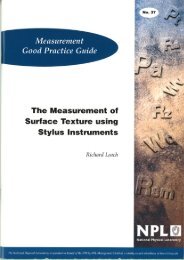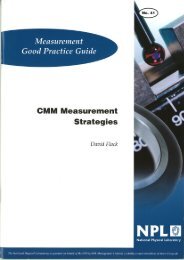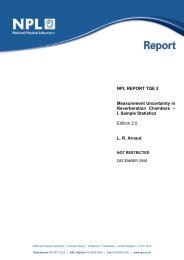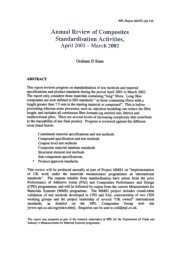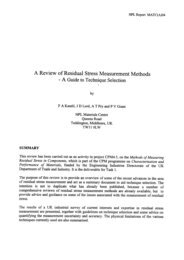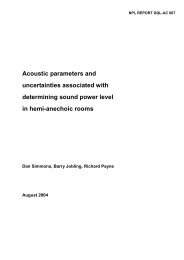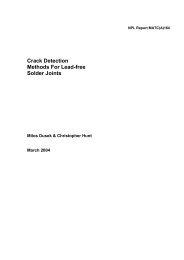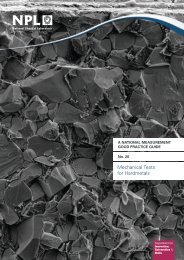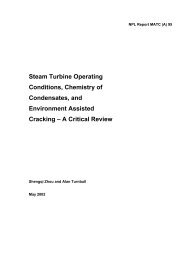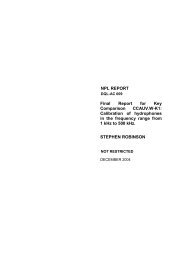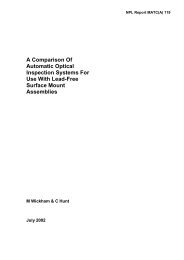Protocol for Establishing and Maintaining the Calibration - NPL ...
Protocol for Establishing and Maintaining the Calibration - NPL ...
Protocol for Establishing and Maintaining the Calibration - NPL ...
You also want an ePaper? Increase the reach of your titles
YUMPU automatically turns print PDFs into web optimized ePapers that Google loves.
4 Good Practice Guide 93 Chapter 1<br />
relevant National Metrology Institute (NMI). In <strong>the</strong> UK, <strong>the</strong> NMI is <strong>the</strong> National Physical<br />
Laboratory in Teddington. The NMI confirms <strong>the</strong> accuracy of its st<strong>and</strong>ards by comparisons with<br />
<strong>the</strong> NMIs of o<strong>the</strong>r countries: <strong>the</strong>se are organised by <strong>the</strong> Bureau International des Poids et Mesures<br />
(BIPM), <strong>the</strong> world measurement st<strong>and</strong>ards authority. This process is generally described as <strong>the</strong><br />
establishment of Equivalence (see Figure 1.2):<br />
Figure 1.2<br />
Traceability <strong>and</strong> equivalence<br />
← E Q U I V A L E N C E →<br />
NIST<br />
(USA)<br />
⇔<br />
<strong>NPL</strong><br />
(UK)<br />
Secondary<br />
St<strong>and</strong>ards<br />
Laboratory<br />
Reference<br />
Instrument<br />
Field<br />
Instrument<br />
⇔<br />
PTB<br />
(DE)<br />
⇔<br />
LNHB<br />
(FR)<br />
⇔<br />
⇔<br />
↑<br />
T<br />
R<br />
A<br />
C<br />
E<br />
A<br />
B<br />
I<br />
L<br />
I<br />
T<br />
Y<br />
↓<br />
There are a number of ways in which traceability can be established <strong>and</strong> <strong>the</strong> uncertainty associated<br />
with <strong>the</strong> calibration factor will depend to a large degree on <strong>the</strong> calibration method used. Two<br />
possible calibration methods used by manufacturers are:<br />
(a)<br />
(b)<br />
The master system is calibrated <strong>for</strong> each radionuclide using primary st<strong>and</strong>ards.<br />
The manufacturer determines of <strong>the</strong> calibration factors <strong>for</strong> a typical production calibrator <strong>for</strong> a<br />
restricted range of radionuclides using traceable st<strong>and</strong>ards. The response-energy curve is <strong>the</strong>n<br />
calculated <strong>and</strong> calibration factors <strong>for</strong> all radionuclides are calculated from knowledge of <strong>the</strong>ir<br />
radiative emissions <strong>and</strong> <strong>the</strong> response curve. Additional uncertainties <strong>the</strong>n need to be included<br />
to allow <strong>for</strong> manufacturing differences between <strong>the</strong> “typical” calibrator <strong>and</strong> all o<strong>the</strong>r<br />
production models.<br />
These two examples might be regarded as <strong>the</strong> extremes in terms of <strong>the</strong> resultant uncertainties on<br />
individual calibration factors. There are o<strong>the</strong>r options <strong>and</strong> <strong>the</strong>se can also be supplemented by<br />
subsequent calibrations <strong>and</strong> comparisons that will provide opportunities to reduce <strong>the</strong>se<br />
uncertainties.<br />
A practical method to ensure traceability to <strong>the</strong> national st<strong>and</strong>ard is to calibrate, at least annually,<br />
<strong>the</strong> routine instrument (field instrument) against a reference instrument. This can be a “secondary<br />
st<strong>and</strong>ard” instrument <strong>for</strong> which nationally traceable measurements are available <strong>for</strong> a



